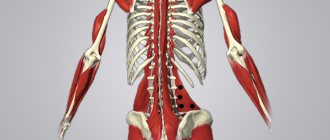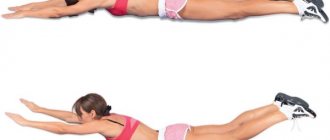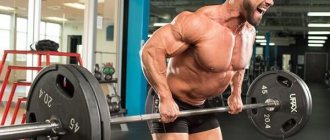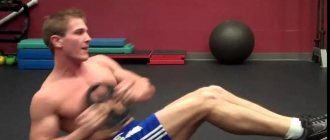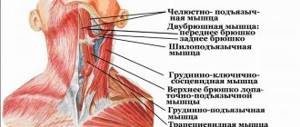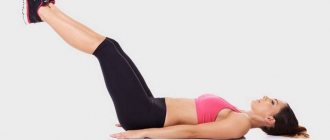How are exercises performed to strengthen the lower back muscles?
During classes you will have to go through three main stages:
- warm-up is a preparatory stage that is necessary to warm up the muscles and prepare them for subsequent loads; it is mandatory because it makes it possible to avoid injuries;
- physical activity is the most active segment of training; during this period, planks, lateral leg raises, arm swings, backbends, and scissors are performed;
- recovery - exercises are performed to relax the lower back muscles and stabilize breathing.
By spending just 10-15 minutes reading this article, you will learn how to strengthen your lower back with simple exercises without leaving your home.
Preparation for exercise therapy
If the examinations are over, the list of appointments is in hand, and the desire to become healthy is still present, it’s time to start preparing for physical exercise. After all, even with the most ardent zeal for the victorious parameters of a healthy body, you need to remember its momentary state and carefully prepare it for serious muscular work. This means you need to warm up first. To do this, exercises with minimal load are selected from the prescribed ones, which will also help determine the amplitude of the basic gymnastic techniques aimed at achieving maximum results. Also, preparation for charging includes the following rules:
comfortable conditions for conducting classes - a ventilated room, sufficiently free in area (classes can also be held outdoors), comfortable clothing, shoes that do not restrict movement; have a light meal an hour or two before the start of classes, because
the body needs enough strength to perform the loads, and at the same time, energy should be directed specifically at them, and not at digesting a hearty lunch; distribution of loads from light to peak in the middle of the lesson; unhurried movements, smooth and calm, which contribute to consistent tension and relaxation of muscles in the order determined by the method; timely recognition of the alarm signals of your body during physical therapy - slight discomfort is acceptable, but in case of acute pain, pulsating pressure, darkening in the eyes, tinnitus and other negative manifestations, it is important to stop the exercise in time or, if possible, switch to more gentle forms of exercise; Regularity of exercise is a necessary condition for achieving the desired health result.
And don’t let the fear of doing harm with what the patient thinks is an excessive load be an obstacle to therapeutic exercises. Exercises, in all their dosages, are also medicine, only not medicinal, but physical, but with a therapeutic effect.
General rules
To strengthen your back muscles and not aggravate the situation further, you need to start with small physical activities, gradually increasing their intensity. Even when performing light exercises, you should not try too hard. If you experience severe pain during exercise that does not go away for a long time, stop exercising and consult a doctor. Perhaps diseases of the internal organs or spine have made themselves known, requiring immediate treatment. Sports are also contraindicated if dizziness and nausea occur.
In case of pathologies of the musculoskeletal system in the acute stage, physical exercise can cause serious damage to health. Therefore, always listen to your body and be able to distinguish fatigue from pain caused by pathology. Pregnant women and people who have previously had spinal injuries should be especially attentive to their health.
Remember that all movements in exercises to strengthen the lower back should be smooth. Do not forget about proper breathing, which will ease the load on the body. To create a comfortable atmosphere in the room where classes will be held, it is necessary to pre-ventilate. Take care of comfortable clothing that does not restrict movement.
An important point: you need to perform a set of exercises for the lower back regularly. Only then will the body get used to the load and the exercises will begin to be beneficial. If you often forget about training and their frequency does not reach two or three sessions a week, you should not count on a positive result. It is also important to follow the correct exercise technique, which should be performed by a specialist.
Why does back pain occur?
- Ayurveda, the oldest known treatise on health and longevity, distinguishes only two causes of diseases: blood does not flow where it should and blood flows where it should not flow.
- Based on this concept, in order to treat and maintain the body in a healthy state, it is first necessary to normalize the natural circulation and blood flow in the human body, and one of the ways is to perform special exercises, asanas, which are described in numerous Vedic treatises.
- Complexes of therapeutic and rehabilitation gymnastics are also used by modern medicine, including in the treatment of diseases of the lumbar region. Many of the exercises are very similar to yoga asanas, which indicates their time-tested effectiveness.
- Problems arise due to intervertebral cartilage tissue, its inflammation and mechanical damage. People with a weakened muscular system are at greater risk for these diseases: the external oblique and internal oblique abdominal muscles, the thoracolumbar fascia, and the latissimus dorsi muscle.
- They form a kind of corset that holds and protects the spinal column from injury and damage. The weakening of these muscles is especially dangerous when the hip part is disproportionately massive, which increases the risk of injury not only when bending the upper part, but also when moving overhead, with twisting, of the lower part of the body.
Warm-up
To warm up the lower back muscles and prepare them for the upcoming load, each session should begin with a warm-up. Proper preparation will help avoid severe pain and sprains.
For a good warm-up, it is recommended to perform three basic exercises:
- Lying on your back, bend your knees and relax your spine.
- Stay in the same position. Press your spine into the floor, freeze for a couple of seconds, then relax. Repeat the same ten times.
- In the same position, lift your buttocks off the floor, keeping your body straight, freeze for a few seconds, then take the starting position. Repeat 10-12 times.
Exercises
After warming up, you can begin basic exercises to strengthen the spine. Most of them are distinguished by elementary technology and are familiar to many from the school curriculum. Regularly performing even simple exercises will help strengthen the muscles of the lower back and create good support for the spine.
"Boat"
Lie down on the floor, lift your arms and legs up or forward to form a “boat”. Stay in the position until you get tired, then return to the starting position. At least 10-15 repetitions are required. For beginners who are just starting to practice, 7-8 times are enough.
Lunges
Get on all fours and perform alternating lunges with your left and right legs. The exercise can be made a little more difficult by using your hands.
Leg raises
Lying on your stomach, alternately lift your left and right legs, holding this position for a few seconds. At least three to five such alternations should be performed.
Side plank
Lying on your side, rest your elbow on the floor. Then raise your hips as high as possible and hold this position for 10 seconds. Change position, turning over to the other side, repeat the same thing. Gradually, the time spent in the side plank pose can be increased to 30 seconds. To effectively strengthen the spinal muscles, you need at least 10 approaches for each hip.
A version of this exercise is demonstrated by the founder of the Drevmass company:
Deflections
Lying on your back, try to lift your chest, lower back and pelvis as high as possible from the floor. The legs and entire body should remain straight. This exercise will be made easier by the correct breathing technique - inhale while lifting, and exhale when returning the body to its original position. This exercise is useful not only for the spine, but also for the hip muscles.
"Scissors"
Lie on your back, hands behind your head, raise both legs, spread them to the side and cross them. Repeat the movements at least 7-8 times. A similar exercise can be performed in the prone position.
Hyperextension
You can perform this exercise only if you have a fitness ball. Rest your hips on the ball, hands behind the back of your head, legs locked. Lift your torso without reaching the top shelf. Your back should remain straight while performing the exercise. Repeat hyperextension 10-12 times in several approaches.
"Snake"
This is one of the popular yoga exercises for spinal flexibility and strengthening the back muscles. Take a position lying on your stomach, rest your palms on the floor and bend your back as much as possible.
Child's Pose
Spinal stretching exercises are also successfully used in yoga. Sit on your heels, extend your arms forward and slowly bend with your entire upper body. Stretch forward well and stay in this position for a few seconds. Also gradually return to the starting position.
Check out another set of exercises from this video:
Anatomical features
The lower back bears the heaviest load, so the muscles get tired and weak.
The lower back is the part of the body between the tailbone and the ribs. Divided into equal halves by the spine. The latter consists of 5 massive wide vertebrae. Between them are the intervertebral discs - a formation of the fibrous ring and the nucleus pulposus in it. The discs absorb the load when pressure increases and during movement.
The spine serves as a support for the body, but at the same time maintains very high mobility. A huge number of short muscles ensure rotation of the vertebrae and stabilization: anterior, posterior, interspinous, interarch, intertransverse. They are attached to the processes in different directions, connecting pairs of vertebrae to each other. Muscles provide support for each vertebra.
The large superficial muscles of the lumbar region include 4 groups:
- Extensors – longissimus, spinalis, iliocostal. They are placed almost along the entire length of the spine and provide support and straightening of the ridge.
- Anterior flexors - rectus and oblique abdominal muscles, psoas major and iliacus. Responsible for flexion and extension of the body in the lower back.
- Lateral flexors – quadratus, oblique transverse abdominal muscles. Provide lateral movements.
- Rotators - semispinalis, multifidus, rotator muscles - all flexor and extensor muscles with an oblique bevel.
Superficial muscles are responsible for upright posture, rotation and bending, movements of the arms and legs under any load. Together with the short ones they provide nutrition to the vertebrae.
Swimming
Swimming is one of the most effective methods of strengthening the lower back muscles. In the warm season you can exercise in a pond, in the cold season you can visit the pool. To avoid heavy stress on the body, beginners are advised to swim no more than 20-30 minutes several times a week. Gradually, as the muscles strengthen, the duration of classes can be increased to one hour.
In the pool you can not only swim, but also perform the following types of exercises:
- Grab the handrail and squat on each leg alternately.
- Slowly make vertical turns of the body - at least 10 times.
- Hold onto the handrail and imitate riding a bicycle.
Perform the swallow exercise, holding the handrail with one hand and lifting the opposite leg forward with the other.
Contraindications and precautions
Exercises are selected based on the person’s physical fitness.
There are absolute contraindications for any complex:
- injuries, serious illnesses of internal organs;
- recovery time after surgery;
- infectious diseases, acute. You cannot exercise at temperatures above 38 C;
- oncology.
Otherwise, restrictions are related to the severity and nature of the disease and general condition. In case of hernias and protrusions, strength exercises are limited - complexes with a high axial load are prohibited. At the same time, you cannot refuse to strengthen your core muscles. For osteochondrosis, exercises are performed to correct the ridge and pump up the back.
Therapeutic exercise
For such serious diseases as osteochondrosis or rheumatism, when physical activity is contraindicated for the patient, special therapeutic exercises are necessary. A set of simple exercises will help eliminate inflammation, relieve pain, and stretch the spine without side effects.
Basic therapeutic exercises:
- Lying on your back, raise your legs and clasp them with your arms. Hold this for as long as possible. Then lower your legs, rest a little and do at least five repetitions.
- Stay in the same position, only place your hands on the floor perpendicular to your body and bend your legs at the knees. Make turns - with your head to the left and your feet to the right, then vice versa. Repeat ten times. This exercise helps to gradually and safely strengthen the muscles of the lower back.
- Now your legs are not just bent, but also shoulder-width apart. Take a deep breath and press your buttocks into the floor as hard as possible; when exhaling, you need to raise your chest as high as possible. Repeat the same as the previous exercises at least ten times.
If you suffer from chronic diseases of the spine, then even before performing therapeutic exercises, you should consult your doctor.
Possible contraindications and side effects
When turning to therapeutic exercises for various problems and diseases of the lumbar and lumbosacral spine, it is important to understand the need for discussion with a specialist. Only professional medical participation will allow you to achieve maximum results taking into account the current factors, as well as avoid possible negative manifestations and unwanted side effects, such as:
- general deterioration in well-being due to incorrectly calculated load and incorrectly selected exercises;
- aggravation of existing diseases, especially chronic ones, for example, scoliosis to any degree, pathologies of the genitourinary system, which are most closely related to the lumbar and sacral vertebrae by direct innervation;
- inflammatory processes in any part of the body, as evidenced by increased body temperature, pain, weakness;
- poor circulation in the lower extremities, which is expressed by the effect of cold legs, weakness in them, swelling and even cramps;
- microtraumas and more serious injuries that are possible in old age due to an incorrect set of exercises or excessive enthusiasm of the patient.
Old age during exercise therapy is a factor that requires special attention from a specialist
Thus, in order to avoid the listed or other consequences of exercise therapy for the lower back, it is necessary to strictly follow the treatment instructions and not neglect the prescriptions, recommendations and prohibitions on physical activity. The latter are possible due to the following contraindications: any disturbances of blood circulation, heart rhythm, cardiovascular diseases and associated increased blood pressure, headaches, an identified predisposition to strokes.
How else to take care of your lower back?
Exercises to strengthen the muscles of the lumbar spine are not the only option for the prevention and treatment of various diseases of the musculoskeletal system. Regular visits to the pool and exercise therapy classes will bring benefits. If you are diagnosed with osteochondrosis, you should definitely consult your doctor before training.
How to strengthen the lower back at home for men and women? For this purpose, a special device has been created - the Drevmass simulator. It has established itself as an effective remedy for the prevention and treatment of various diseases of the musculoskeletal system. The main advantages of Drevmass include:
- versatility, it is suitable for representatives of both sexes of any age categories;
- environmental and structural safety;
- quick results; with regular training for 5 minutes a day, you will notice an improvement in your condition within 3 weeks;
- ease of use and the ability to change the position of the rollers to work on a specific part of the spine;
- affordability; purchasing a massager will cost less than visiting specialized offices, chiropractors, and trainers.
You can learn more about the process of strengthening the lower back with the help of exercises and Woodmass from our specialists.
Indications and contraindications
When there is curvature of the spine, special corrective exercises are indicated.
The need to seriously engage in strengthening the muscles of the spinal corset is indicated by the appearance of the following conditions:
- Poor posture - pathological kyphosis or stoop (excessive backward deflection in the thoracic spine), lordosis (a similar forward deflection of the lumbar sector of the spine).
- Curvature of the spine in the lateral projection – scoliosis.
- Degenerative-dystrophic changes in the vertebral bodies and intervertebral layers, leading to the development of osteochondrosis, spondylosis, spondyloarthrosis.
Strengthening gymnastics can certainly be indicated only in the initial stage of disease development. When they move into subsequent stages, the question of the need/admissibility of increasing the load on the muscle corset is decided by the attending physician after a thorough examination of the patient. Depending on the condition, intense exercise can be either beneficial or harmful.
For grades 3-4 scoliosis, performing exercises on your own is contraindicated.
Vertebrologists include contraindications for such activities:
- kyphosis, lordosis and scoliosis of the fourth degree, when the angle of curvature of the spine reaches 70 degrees or more;
- developed osteochondrosis, spondylosis, spondyloarthrosis, in which the vertebral bodies are severely deformed, the spinal column is overgrown with spiny lateral growths - osteophytes;
- multiple protrusions and hernias of intervertebral cartilaginous discs.
In this case, gymnastic movements can contribute to pinching of the spinal nerve roots extending from the spine, causing acute pain of a shooting nature. However, in this condition, we are not talking about a complete ban on physical activity, but only about a transition from recreational to therapeutic exercises. This type of physical education has its own specifics and must be carried out in strict accordance with the recommendations of the attending physician and exercise therapy instructor.
